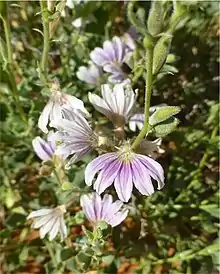| Scaevola parvibarbata | |
|---|---|
 | |
| Scientific classification | |
| Kingdom: | Plantae |
| Clade: | Tracheophytes |
| Clade: | Angiosperms |
| Clade: | Eudicots |
| Clade: | Asterids |
| Order: | Asterales |
| Family: | Goodeniaceae |
| Genus: | Scaevola |
| Species: | S. parvibarbata |
| Binomial name | |
| Scaevola parvibarbata | |
Scaevola parvibarbata is a species of flowering plant in the family Goodeniaceae. It is an upright herb with fan-shaped mauve or greenish flowers and grows in New South Wales, Queensland, South Australia and the Northern Territory.
Description
Scaevola parvibarbata is an upright herb to 50 cm (20 in) high and covered with simple hairs. The leaves are round to oblong-lance shaped, sessile, 8–40 mm (0.31–1.57 in) long, 4–20 mm (0.16–0.79 in) wide and the margins mostly toothed. The flowers are borne in spikes up to 25 cm (9.8 in) long, bracts small and leaf-like, corolla 11–25 mm (0.43–0.98 in) long, mauve or greenish, thickly bearded with simple hairs on the inside, curled or spreading hairs on the outer surface and the wings up to 1 mm (0.039 in) wide. Flowering occurs mostly from May to October and the fruit is egg-shaped, hairy, 3–5 mm (0.12–0.20 in) long and the surface wrinkled.[2][3]
Taxonomy and naming
Scaevola parvibarbata was first formally described in 1986 by Roger Charles Carolin and the description was published in Flora of South Australia.[4] The specific epithet (parvibarbata) means "small" and "bearded".[5]
Distribution and habitat
This scaevola grows in dry, sandy locations in New South Wales, South Australia, Queensland and the Northern Territory.[2][3]
References
- ↑ "Scaevola parvibarbata". Australian Plant Census. Retrieved 30 April 2022.
- 1 2 Carolin, R.C. "Scaevola parvibarbata". PlantNET-NSW flora online. Royal Botanic Garden Sydney. Retrieved 3 May 2022.
- 1 2 Carolin, R.C (1990). Flora of Australia 35 (PDF). Canberra: Commonwealth of Australia. p. 123. Retrieved 3 May 2022.
- ↑ "Scaevola parvibarbata". Australian Plant Name Index. Retrieved 3 May 2022.
- ↑ Sharr, Francis Aubi; George, Alex (2019). Western Australian Plant Names and Their Meanings (3rd ed.). Kardinya, WA: Four Gables Press. p. 143 & 271. ISBN 9780958034180.